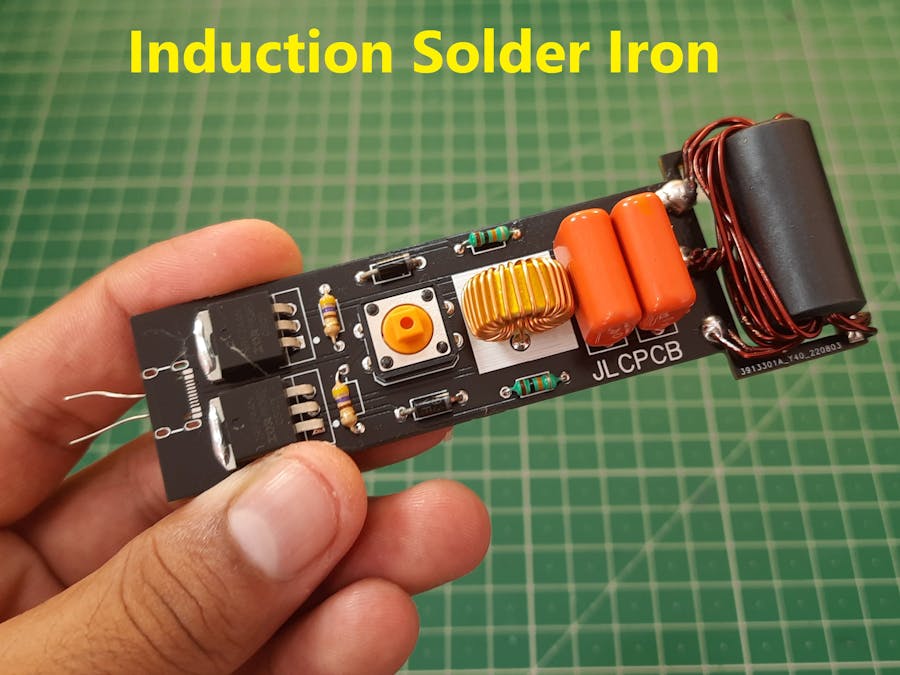Induction heaters are trending the new market nowadays. They are cheap but the cost of maintenance is quite high. They are able to draw a very high current from the supply. Then use induction phenomena to heat the material. TO be more specific about the design of induction, they use a big coil, MOSFET and some oscillator circuity. Induction is modified form of inducing current into second conductor.
Coils can produce voltage across the terminal when placed in moving magnetic field. And by the same method a noticeable amount of voltage drop can be measured in the coil when placed near to an oscillating coil. The same amount of magnetic flux is induced in the secondary coil. But there are some current losses given by eddy current. PCB of this project is sponsored by JLCPCB
Induction working:I follow the induction tutorial by electronoobs, here you find the one. He explained the working and circuit designing. Also, the animations made by him are really increase the understanding. In this he explained the working of induction heater. But we are going to build an induction soldering iron so there might be some changes in circuit.
I just skipped the working part here, but a change in circuit is that instead of using the secondary coil we are using a copper wire of 1mmx 3. You will find the building instruction of this soldering iron below in detail.
Components required:1) Ferrite core
2) 1mm copper enameled wire
3) IRFZ44N Mosfet
4) 1uf polyester film capacitors
5) 10k, 470-ohm resistors
6) Tactile button
7) Power supply 10 amperes
8) Custom PCB from JLCPCB
Circuit diagram:I used MOSFET for alternate switching, 2 fast switching diodes are connected to the gate terminals. 10k and 470 ohms resistor for proper biasing and a tactile button for switching on/off. I also made a place for USB type C but I think this is not able to work with such a high ampere.
2 polyester film 1uf capacitors with 200uh coil forms the LC filter. A special output coil is made from a long ferrite core. This circuit is very stable and MOSFET don’t heat too much but keep the voltage under 15 volts and current can be limited to a maximum of 5Amperes.
LC filter making:This consists a ferrite inductor and polyester capacitors. I used 200uh inductor and it is made using a 1cm x 0.7 cm round toroidal ferrite core. You may find the one in old CFL bulb.
I made 15 turns of 0.6mm wire in clock wise direction. You can make the coil according to the used wire. Online coil calculators are also available to predict the value of number of turns and thickness of wire. Here I am using 400volt capacitors, higher the ratings better are the output and overall protection.
How to make a coil:For the main output coil, a big toroidal coil is need and instead of using a round ferrite core I am using a long length core. You can find this one in the old laptop charge cable or in any old tv cable.
These ferrite cable core is designed to clean common mode noise (signal) generated from either a signal line or power cable. But nowadays SMPS become too advance so not used with new ones.
I used centre tapped coil of 1mm x 3 of 2 rounds. And for the output the same 1mm x 3 wire of 1 round is used.
PCB files:You can download these PCB files from here in case if you want to go with same designs. I made these designs very carefully and all the tracks width is adjusted manually so that it can bear high current situations. Because of the stable circuit Mosfet would not heat too much so I made the on-heat sink pads. I prefer you to go with the aluminum board instead of FR4.
I generated the Gerber files from the modified schematics. Then I uploaded the Gerber files to JLCPCB- one of the leading PCB manufacturer form China. Offers 5 Pieces of 2layer board in just $2. Sign up now to JLCPCB to get free coupons of worth $54.
Working of induction soldering iron:After assembling all the components, I test this circuit by giving power. Nothing is connected on the output still the power consumption is 1ampere @12volts. These are because of eddy current power losses in the wire. And the output toroidal start to heat after 2 minutes of constant usage.
Then I connected a piece of nichrome wire to the output and the induction conditions are working well. It can consume up to 10 amps but I limited the supply current to 5 amperes. Still the best result, easy to solder and the nichrome wire is Turing into hot red.
In the next version I will update some safety features and design. I it is better to use a high-power DC jack instead of USB. Then a proper 3D case for best handing and practically using. No need of any type of cooling, Aluminum pcb is best. A very thanks to JLCPCB for sponsoring this project.









Comments
Please log in or sign up to comment.